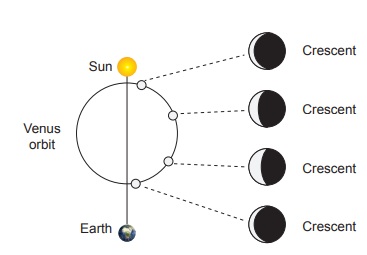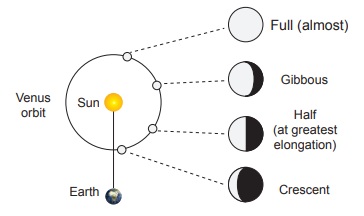Universe and Space | Term 3 Unit 2 | 7th Science - Epicycles | 7th Science : Term 3 Unit 2 : Universe and Space
Chapter: 7th Science : Term 3 Unit 2 : Universe and Space
Epicycles
Epicycles
Moon going around Earth with 27 day
period nicely explained its motion. However astronomers in ancient times faced
problem in explaining the motion of the then known five planets- Mercury,
Venus, Mars, Jupiter and Saturn.
Moon
in the background of stars moved everyday eastwards nicely. However for
example, if we were observing the motion of Mars from January , it would appear
to move eastward in the
background stars. That is the position of mars today will be near a star which
is east of the star near which it was yesterday. However on June 28 , we will
see a change. From that date the Mars would appear to move west rather than its
normal eastward motion. This reversal of direction of planets is called as
‘retrograde motion’. If we continue to observe, on August 28 once again the
Mars would appear to reverse the direction and again on its usual eastward
motion in the celestial sphere. Usually Jupiter is brighter than Mars, however,
around the period of retrograde motion the Mars was much bright than other
times; even brighter than Jupiter.
Other planets also exhibited number
of puzzling behaviours. Venus and Mercury always appeared very close to Sun,
and hence never appeared in the midnight sky. The brightness of Jupiter also
varied again when it exhibited retrograde motion. For example in 2018, Jupiter
reversed its direction of motion on March 9, 2018 and again resumed its normal
eastward motion on July 11, 2018.
The simple geocentric model, where
planets go around the Earth could not explain why the brightness of the planets
changed, and why they reversed their directions. Change in brightness and
retrograde motion would be impossible if we assumed that the planets were at
the same distance at all times from Earth.
To explain the puzzling phenomena
astronomers in early times proposed a change in the simple geocentric model.
This is called as epicycle model.
Ptolemy (2nd cent) in Greece,
Aryabhatta in India and others used the epicycle model to explain the motion of
the celestial objects. Their models were improved by generation of
astronomers like
Tycho Brahe and Neelakanta Somayaji.
Although, the model explained many
phenomena there were number of mismatches. The model was becoming messy.
Arrival
of telescope.
Telescope was invented by Hans
Lippershey but Galilio used it for studying the sky for the first time. The
telescope showed more universe was than visible to naked eye. With his simple
telescope matching toy telescopes of today, Galilio was able to see mountains
on the Moon, small dim stars invisible to naked eye, sunspots on the face of
Sun. He was able to demonstrate that the milky way, an hazy bright patch in the
sky is nothing but thousands of stars huddled together, Jupiter had moons going
around it and Saturn had mysterious appendage which we now know as rings.
One of the most startling
observations he made was related to telescopic observation of Venus. This
convinced him to accept the theory of the Polish Astronomer Nicolus Copernicus,
that it is not Sun, planets and Stars that go around Earth, but it is Earth and
other planets that go around the Sun- heliocentric theory.
Heliocentric
model.
Dissatisfied with the messy epicycle
model Nicolus Copernicus, radically proposed that the model will become simple
if we assume Sun is at the center and all planets, including Earth, go around
it.
Suppose, Earth and Mars are on the
two sides of the Sun, then Mars would be far and appear dim, compared to when
they are on the same side. Earth orbit around Sun in 365 days, whereas Mars
takes 687 days. This implies at times Earth will overtake Mars. When
the Earth is approaching and overtaking Mars, the Mars would appear to exhibit
retrograde motion. In short all the observed phenomena could be explained in a
simple way.
However
how do we know that actually Sun is at the center or not?
Galileo found that his observation
of Venus gave the observational evidence to support the heliocentric theory.
Galileo observed Venus in 1610-1611 with a telescope. To naked eye, Venus is
just a gleaming bright spot. However, through a telescope, the shape of the
planet can be seen. Galilio was startled to find like Moon Venus too exhibited
phases. The shape varied from crescent to gibbous. Also, the size of the planet
varied. When the planet was in gibbous phase the size was small, and when it
was thin crescent the size was many folds higher.

As the Venus went around the
epicycle, as shown in the diagram Venus would exhibit phases. Also at times the
planet would be nearer, making the apparent size grow bigger and at times far
making the apparent size smaller. Thus, the variation in the brightness can
also be explained.
It became clear to Galilio that the
geo-centric epicycle model will not help in accounting for the observed phases
of the Venus.

Look at the above diagram. If the
Venus was going around the Sun, and its orbit is inside that of Earth, Venus
would appear always near the Sun in the sky. It can never be seen in the
midnight sky. Two when it is near the
Earth, it would be brighter and bigger compared to when it is on the other side
of the Sun . Thirdly only if the Venus is revolving around the Sun, it can
exhibit gibbous phase, and the size of the gibbous phase smaller than the
crescent phase. If the Venus was revolving around the Earth, we can never see
the gibbous phase of the Venus and it would be seen only if it is orbiting tthe
he Sun. This clinching observational evidence proved that at the least Venus
orbited around the Sun. Further evidences collected by astronomers using
telescope and other advanced modern instruments gave enough evidence that all
planets revolve around the Sun.
If Galileo were around today, he
would surely be amazed at exploration of our solar system and beyond by ISRO,
NASA, Russian space agency and others.
Now we can observe planets orbiting
around other stars (called exoplanets), proving that not only planets orbit
around the Sun in solar system, but all around the universe such planetary
systems exist. Who knows, in some of there could be life and in rare cases
intelligent life, like humans wondering and exploring universe. Imagine a
future time when such life meet us; how exciting and momentous it would be!
Related Topics